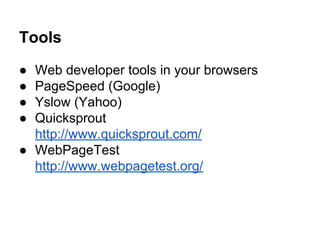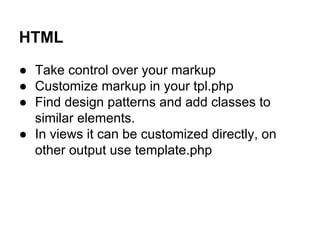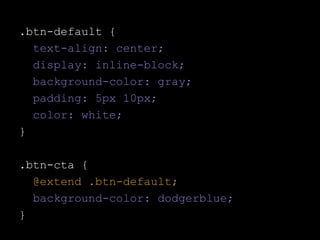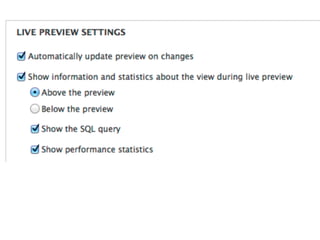Ad
Drupalcamp performance
- 1. WWLLC What Would Lucky Luke Code? Create Drupal sites with good performance
- 4. The frontkom family Per André Rønsen Marco Fernandes CIO/Chief Innovation Officer Senior Web developer Fredrik Paus Élio Cró Jan-Helge Hansen COO/Project Manager Web Developer Infrastructure / support Thor André Gretland Roberto Ornelas Support & Training CTO Senior developer Fábio Neves Geir Gulland Hélder Mendes Bruno Campos CEO / Web strategist Web Designer Web developer Frank Gjertsen Elisabeth Gulland Wilma Web Designer Accountant QA Engineer ;) Henrik Akselsen JS/Mobile UX Web developer
- 7. SHOWTIME
- 8. Why performance now? ● We got fast internet connections ● Powerful computers ● Shiny large screens …but wait, we got mobile. …and bad mobile connections. …and emerging markets which are mobile only.
- 9. Web pages are getting FAT 1.5MB Expect to increase by 21% the next year ● Today the average page is ● ● Oakley released their new site. 80MB
- 10. When to start? ● Post-optimization is the root of all evil ● Lack of performance = Lack of planning ● Bad performance is bad business ● ● ● ● We need our clients interest in performance Show visually how a page loads Make a performance budget Plan performance from the beginning
- 11. We need to analyze this
- 12. “Yeah, it’s slow, but it’s probably just [insert wild speculation here]”
- 13. Hold your assumptions ● A lot of the time your assumption will be wrong and cause a lot of wasted effort ● Let the data guide the optimizing process ● Use the 80/20 rule => find low hanging fruit
- 14. Tools ● ● ● ● Web developer tools in your browsers PageSpeed (Google) Yslow (Yahoo) Quicksprout http://www.quicksprout.com/ ● WebPageTest http://www.webpagetest.org/
- 17. Indepth analysis Chrome Dev Tools XHProf (Backend) Frontend Introduction to dev tools http://bit.ly/discover-devtools Find out which functions that are using memory and processor time “The Breakpoint” Paul Irish / Addy Osmani
- 18. Mobile first
- 19. Mobile first ● Start small. Add style and content as you get more space, without limiting the user experience. http://bradfrostweb.com/demo/mobile-first ● Build systems instead of individual pages ● Write reusable code
- 20. Mobile first ● ● ● ● Download as few MB as possible Reduce requested files. Images, css, js. Concatenate and minify css and js Make sprites ○ Compass does this in a smart way… ● Or use icon fonts ○ http://iconmoon.io ○ or even better http://fontastic.me
- 21. HTML ● Take control over your markup ● Customize markup in your tpl.php ● Find design patterns and add classes to similar elements. ● In views it can be customized directly, on other output use template.php
- 22. <section class="panel-pane paneviews-panes pane-commons-featuredpanel-pane-1 block">...</section> <section class="panel-pane paneviews-panes pane-commons-activitystreams-activity-panel-pane-1 block">...</section>
- 23. function theme_preprocess_panels_pane(&$vars) { switch ($vars['pane']->pid) { case '14': $vars['classes_array'][] = 'box-default'; break; case '8': $vars['classes_array'] = array('box-default'); break; } }
- 24. <section class="panel-pane paneviews-panes pane-commons-featuredpanel-pane-1 block box-default"> ... </section> <section class="box-default"> ... </section>
- 25. Useful gh-repo http://bit.ly/template-php by Jesper Wøldiche Rahkonen
- 26. Clean markup ● Modules ○ Clean Markup - Blocks, Panel panes, Panel regions, Panel layouts https://drupal.org/project/clean_markup ○ Fences - clean fields markup globaly. https://drupal.org/project/fences
- 27. Default fields markup <div class="field field-name-field-test field-type-text field-label-above"> <div class="field-label">Foobar field: </div> <div class="field-items"> <div class="field-item even">Drupal default fields markup.</div> </div> </div>
- 28. After fences config <h3 class="field-label">Foobar field</h3> <div class="field-foobar">Leaner markup means better front-end performance. </div>
- 29. Clean markup ● Modules ○ Clean Markup - Blocks, Panel panes, Panel regions, Panel layouts https://drupal.org/project/clean_markup ○ Fences - clean fields markup globaly. https://drupal.org/project/fences ● Themes ○ Mothership https://drupal.org/project/mothership ○ Aurora https://drupal.org/project/aurora
- 30. CSS ● Write as little as possible ● Use classes instad of tags ○ ul li a {} ○ .nav-main .nav-item {} ○ http://bit.ly/quick-selectors ● Css can get out of control and hard to manage when a page scales
- 31. .btn-default, .btn-cta { text-align: center; display: inline-block; background-color: gray; padding: 5px 10px; color: white; } .btn-cta { background-color: dodgerblue; }
- 32. SMACSS ● A must read for all working with css ● Part of the book is available online for free http://smacss.com
- 34. Preprocess that CSS ● LESS ● Stylus ● Sass ○ ○ ○ ○ WARNING! Compass - Sass mixins library and much more Breakpoint - Really Simple Media Queries with Sass Toolkit - swiss army knife for PE and RWD Singularity - Grids withoutyour output Always check limits
- 35. .btn-default { text-align: center; display: inline-block; background-color: gray; padding: 5px 10px; color: white; } .btn-cta { @extend .btn-default; background-color: dodgerblue; }
- 36. .btn-default, .btn-cta { text-align: center; display: inline-block; background-color: gray; padding: 5px 10px; color: white; } .btn-cta { background-color: dodgerblue; }
- 37. Javascript ● Don’t load js before css ● Don’t load libraries you don’t need, and if possible make custom builds to your needs. E.g. Modernizr. ● Try to move most of your js at the bottom of your page, just before </body>. There is a special Drupal module for this. ● Avoid unnecessary dom manipulations
- 39. Avoid calculations in loops var div = document.getElementById("to-measure"), lis = document.getElementsByTagName('li'), i, len; for (i = 0, len = lis.length; i < len; i++) { lis[i].style.width = div.offsetWidth + 'px'; }
- 40. Improve Perceived performance ● Edge side includes ● Image lazy loading
- 42. Hosting ● Geography - Closer is better. ○ (Sorry New Zealand) ● SSD is awesome ● Quick and good support ○ (Sorry New Zealand) ● Consider dedicated Drupal hosting ○ Fx Pantheon (has great workflow)
- 43. PHP & MySQL PHP version: newer is better InnoDB > Myisam
- 44. APC - Opcode cache - Easy setup, huge performance win - See https://drupal.org/node/1777090 for configuration tips for Drupal - Remember to assign enough memory, or the cache will not have any effect
- 45. Memcache(d) Improves editor experience + faster site building Memcache module not needed, just include in settings.php Alternative: Redis
- 46. // the path to the core cache file include_once('./includes/cache.inc'); // the path to the memcache cache file include_once ('./sites/all/modules/contrib/memcache/memcache.inc'); // make MemCacheDrupal the default cache class $conf['cache_default_class'] = 'MemCacheDrupal'; $conf['memcache_servers'] = array('127.0.0.1:11211' => 'default'); $conf['memcache_bins'] = array('cache' => 'default'); $conf['memcache_key_prefix'] = 'mysite';
- 47. First time using memcache
- 49. High performance with cloud ● CDN ● Amazon AWS for static files and images ● Web Application Streaming ○ new tech, possible “CDN killer”) ○ from InstartLogic
- 50. Drupal
- 54. Good places to hang out ● high performance group on d.o ● Contrib modules
- 55. Module strategy ● As few modules as possible ○ Avoid the buffet syndrome ● Check which hooks are used. ○ hook_init() is more important to watch than hook_openid_normalization_method_info_alter() ● Preferred: Measure before/after install ○ Dive into xhprof ○ Disable suspected performance hogs
- 56. Module strategy ● Check that page cache is not being disabled ○ ○ ○ ○ ○ drupal_page_is_cacheable(FALSE); $GLOBALS['conf']['cache'] = 0; $GLOBALS['conf']['cache'] = CACHE_DISABLED; $conf['cache'] = FALSE; flags module, captcha module (This may have to be necessary, but at least know that it is happening)
- 57. Watch the Logs ● Keep an eye on the dblogs ● May slow down disk if constantly logging errors ● May point to underlying errors ● Bad Karma ● Tip: Get sent an email on each log error
- 58. Cache ● ● ● ● Views Cache! PHP blocks breaks cache D7: contrib provides a lot D8: Much more flexible out of the box ○ pluggable CSS and JavaScript optimization ○ personalize through JavaScript ○ Entity Cache
- 60. Be kind to the theme layer ● Avoid logic in the theme layer ○ hurts page cache ● Avoid heavy processes in the theme layer ○ node_load ○ sql queries ● Tip: Switch to another theme and do performance tests again
- 62. Views queries
- 64. Find candidates for optimizing [mysqld] log_slow_queries=/Applications/MAMP/logs/mys ql_sql_slow.log long_query_time=0.5 LOTS OF JOINS SELECT * FROM mother_of_all_huge_tables
- 65. Keep an eye on PAGERS DISTINCT COUNT JOINS
- 66. Optimize Views Queries Battle plan: Find JOINS and see if you can do the same within SELECT Tip: use EXPLAIN on views sql How many evaluations
- 67. No JOIN select nid FROM node; 200005 rows in set (0.08 sec) Data from astonishdesign.com
- 68. 1 JOIN select n.nid, s. field_school_name_format FROM node n LEFT JOIN field_data_field_school_name s ON n.nid = s.entity_id; 200005 rows in set (1.09 sec)
- 69. 2 JOINS select n.nid, s.field_school_name_format, si.field_school_id_value FROM node n LEFT JOIN field_data_field_school_name s ON n.nid = s.entity_id LEFT JOIN field_data_field_school_id si on n.nid = si.entity_id; 200005 rows in set (2.03 sec)
- 70. 3 JOINS select n.nid, s.field_school_name_format, si. field_school_id_value, sp.field_school_phone_value FROM node n LEFT JOIN field_data_field_school_name s ON n.nid = s. entity_id LEFT JOIN field_data_field_school_id si on n.nid = si. entity_id LEFT JOIN field_data_field_school_phone sp on n.nid = sp. entity_id; 200005 rows in set ( 5.03 sec)
- 71. Optimize Views Queries ● Optimize in hook_views_query_alter() and hook_view_query_substitutions() ● Consider making views into a module ○ Easier to optimize + easier version control
- 72. Specific use cases ● Defer heavy tasks ○ Push heavy tasks to cron ○ Batch API ● Fast 404
- 74. Stats Performance module New Relic Load testing with jMeter (+Blazemeter)
- 75. Bring out the big guns ● Ditch the theme layer ● Example: NewsFront
- 76. Now it’s your turn ;-)












![“Yeah, it’s slow, but it’s probably just
[insert wild speculation here]”](https://image.slidesharecdn.com/drupalcampperformance-131118013104-phpapp02/85/Drupalcamp-performance-12-320.jpg)










![function theme_preprocess_panels_pane(&$vars) {
switch ($vars['pane']->pid) {
case '14':
$vars['classes_array'][] = 'box-default';
break;
case '8':
$vars['classes_array'] = array('box-default');
break;
}
}](https://image.slidesharecdn.com/drupalcampperformance-131118013104-phpapp02/85/Drupalcamp-performance-23-320.jpg)















![Avoid calculations in loops
var div = document.getElementById("to-measure"),
lis = document.getElementsByTagName('li'),
i, len;
for (i = 0, len = lis.length; i < len; i++) {
lis[i].style.width = div.offsetWidth + 'px';
}](https://image.slidesharecdn.com/drupalcampperformance-131118013104-phpapp02/85/Drupalcamp-performance-39-320.jpg)






![// the path to the core cache file
include_once('./includes/cache.inc');
// the path to the memcache cache file
include_once
('./sites/all/modules/contrib/memcache/memcache.inc');
// make MemCacheDrupal the default cache class
$conf['cache_default_class'] = 'MemCacheDrupal';
$conf['memcache_servers'] = array('127.0.0.1:11211' =>
'default');
$conf['memcache_bins'] = array('cache' => 'default');
$conf['memcache_key_prefix'] = 'mysite';](https://image.slidesharecdn.com/drupalcampperformance-131118013104-phpapp02/85/Drupalcamp-performance-46-320.jpg)









![Module strategy
● Check that page cache is not being disabled
○
○
○
○
○
drupal_page_is_cacheable(FALSE);
$GLOBALS['conf']['cache'] = 0;
$GLOBALS['conf']['cache'] = CACHE_DISABLED;
$conf['cache'] = FALSE;
flags module, captcha module
(This may have to be necessary, but at least
know that it is happening)](https://image.slidesharecdn.com/drupalcampperformance-131118013104-phpapp02/85/Drupalcamp-performance-56-320.jpg)







![Find candidates for optimizing
[mysqld]
log_slow_queries=/Applications/MAMP/logs/mys
ql_sql_slow.log
long_query_time=0.5
LOTS OF JOINS
SELECT * FROM mother_of_all_huge_tables](https://image.slidesharecdn.com/drupalcampperformance-131118013104-phpapp02/85/Drupalcamp-performance-64-320.jpg)












































































